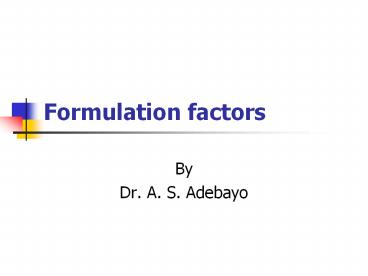Formulation%20factors - PowerPoint PPT Presentation
Title:
Formulation%20factors
Description:
Ingredients Tablet ingredients include materials to break up the tablet formulation - ?? Drug - may be poorly soluble, hydrophobic Lubricant ... – PowerPoint PPT presentation
Number of Views:805
Avg rating:3.0/5.0
Title: Formulation%20factors
1
Formulation factors
- By
- Dr. A. S. Adebayo
2
Objectives
- To discuss the formulation factors which affect
the oral absorption of drug products - To apply the understanding to product selection
- To optimize patients therapeutic benefit from
the designed dosage forms
3
Role of the drug formulation on its delivery to
systemic circulation
- The role of the drug formulation in the delivery
of drug to the site of action should not be
ignored. - With any drug it is possible to alter its
bioavailability considerably by formulation
modification. - Bioavailability of a drug from different dosage
forms would decrease in the order solution gt
suspension gt capsule gt tablet gt coated tablet. - There may be some exceptions but the order
provides a a useful guide as is the case with
pentobarbital aqueous solution gt aqueous
suspension capsule gt tablet of free acid form.
4
Solutions
- Drugs are commonly given in solution in
cough/cold remedies and in medication for the
young and elderly. - In most cases absorption from an oral solution is
rapid and complete, compared with administration
in any other oral dosage form. - The rate limiting step is often the rate of
gastric emptying.
5
Solutions..
- A poor water soluble drug such as phenytoin
presented as a well formulated suspension, of
finely divided powder, may have a better
bioavailability. - Some drugs which are poorly soluble in water may
be dissolved in mixed water/alcohol or glycerol
solvents. - This is particularly useful for compounds with
tight crystal structure, higher melting points
that are not ionic. The crystal structure is
broken by solution in the mixed solvent.
6
Suspensions
- A well formulated suspension is second only to a
solution in terms of superior bioavailability. - Absorption may well be dissolution-limited,
however a suspension of a finely divided powder
will maximize the potential for rapid
dissolution. - A good correlation can be seen for particle size
and absorption rate.
7
Suspensions
- With very fine particle sizes the dispersibility
of the powder becomes important. - The addition of a surface active agent will
improve dispersion of a suspension - may improve the absorption of very fine particle
size suspensions for which caking may otherwise
be a problem.
8
Capsules
- In theory a capsule dosage form should be quite
efficient. - The hard gelatin shell should disrupt rapidly and
allow the contents to be mixed with the G-I tract
contents. - The capsule contents should not be subjected to
high compression forces which would tend to
reduce the effective surface area
9
Capsules..
- Thus a capsule should perform better than a
tablet. This is not always the case. - If a drug is hydrophobic a dispersing agent
should be added to the capsule formulation. - These diluents will work to disperse the powder,
minimize aggregation and maximize the surface
area of the powder.
10
Tablets
- The tablet is the most commonly used oral dosage
form. - It is also quite complex in nature.
- The biggest problem is overcoming the reduction
in effective surface area produced during the
compression process.
11
Ingredients
- Tablet ingredients include materials to break up
the tablet formulation - ?? - Drug - may be poorly soluble, hydrophobic
- Lubricant - usually quite hydrophobic
- Granulating agent - tends to stick the
ingredients together
12
Tablet Ingredients.
- Filler - may interact with the drug, etc., should
be water soluble - Wetting agent - helps the penetration of water
into the tablet - Disintegration agent - helps to break the tablet
apart - Coating agent places additional barrier to drug
dissolution.
13
Sustained release tablets
- Modified release Dosage forms This topic and
the area of sustained release products will be
discussed in more detail in other courses. - Benefits
- for short half-life drugs, sustained release can
mean less frequent dosing and thus better
compliance. - reduce variations in plasma/blood levels for more
consistent result.
14
Problems with sustained-release drug formulations
- More complicated formulation may be more erratic
in result. - A sustained release product may contain a larger
dose, i.e. the dose for two or three (or more)
normal dosing intervals. - A failure of the controlled release mechanism may
result in release of a large toxic dose. - More expensive technology
15
In vitro dosage form testing evaluation
- Disintegration
- Disintegration time is the time to pass through a
sieve while agitated in a specified fluid. - It indicates the time to break up into small
particles, not necessarily the time to go into
solution.
16
DissolutionRate
- Assesses the time is takes for the drug to
dissolve from the dosage form. - Numerous factors affect dissolution.
- Dissolution medium (may be water, simulated
gastric juice, or 0.1M HCl)) - Agitation intensity
- Temperature (usually 37C ) are carefully
controlled. - The apparatus and specifications may be found in
the BP/USP.
17
DissolutionRate Methodology
- Other unofficial methods are used because they
may be faster, cheaper, easier, sensitive to a
particular problem for a particular drug, or
developed by a particular investigator.
18
In-vitro/In vivo correlations (IVIVIC)
- Dissolution tests are used as quality control to
measure variability between batches which may be
reflected by in vivo performance. - In vitro test may be a quick method of ensuring
in vivo performance and considerable work aimed
at defining the in vitro/in vivo correlation has
been done.































